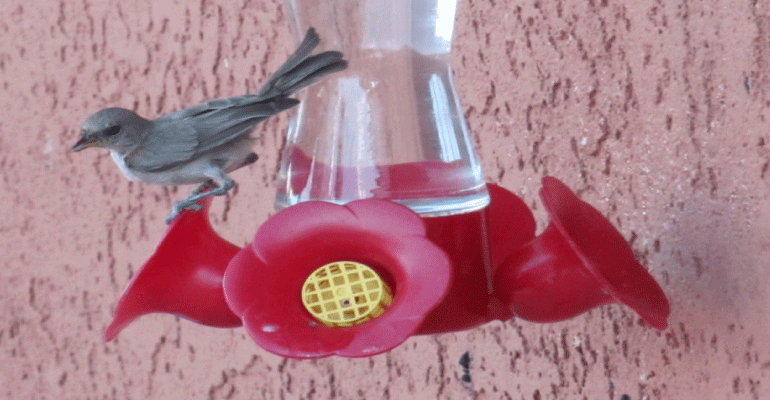
This past Spring, I set out a new hummingbird feeder that would be in the shade during the hot summer days. It was soon discovered by a female Anna’s hummingbird who had to defend it against several other hummers that found it later. (A Costa’s male is now in charge.) The feeder was also discovered by a gang of five little gray birds, the Gnatcatchers. There has been quite a competition between hummers and Gnatcatchers all summer.
There are two species of Gnatcatchers in our region: the Black-tailed Gnatcatcher (Polioptila melanura) which ranges through from Southern Nevada, Southern Arizona and Mexico, and the more wide-ranging Blue-gray Gnatcatcher (Polioptila caerulea) which occurs in most of the U.S. and Mexico. Gnatcatchers are tiny birds, generally 4 to 5 inches long. There is also a California Gnatcatcher which inhabits mainly Baja California. According to Audubon, “Until the late 1980s, this bird was regarded as just a local form of the Black-tailed Gnatcatcher. With its recognition as a full species, it also became an endangered species: its limited habitat along the southern California coast is being taken over by housing tracts and other developments. California Gnatcatchers live in coastal sage scrub, a low shrubby habitat that is also home to other specialized animals and plants.”
The “Sibley Guide to Birds” notes that “distinguishing a gnatcatcher from any other bird is normally a simple task, but separating gnatcatcher species from one another can be difficult.” There are subtle differences in their tails. Gnatcatchers are fidgety birds, so I could not make a positive identification, but I think mine are the Black-tailed Gnatcatcher.

See Google images of the Black-tailed Gnatcatcher and the Blue-gray Gnatcatcher. See also short YouTube videos:
https://youtu.be/L6UB7yPwYOY Black tailed
https://youtu.be/lyGiSnaSCIA Blue-gray
Black-tailed Gnatcatcher:
The Arizona-Sonora Desert Museum describes the Black-tailed Gnatcatcher as “gray above and whitish below. The male has a black cap during the summer that extends to the eyes. The long tail is black with white corners. Females and winter males, lacking the black cap, are difficult to distinguish from the Blue-gray Gnatcatcher. The best way to tell the two apart is the tail: that of the blue-gray is mostly white as viewed from below; the black-tailed is predominantly black underneath.” However, Sibley notes that Gnatcatchers molt their tail feathers during July and August so distinguishing tail marks may be absent.
It’s usual habitat is desert brush, dry washes, and mesquite bosques. “Black-tailed Gnatcatchers live in pairs all year, defending their territory and foraging in trees and low shrubs for a wide variety of small insects and some spiders. Unlike the Blue-gray Gnatcatcher, which it closely resembles, the Black-tailed Gnatcatcher rarely catches insects in midair.”
“The open cup nest, which is typically found in a low shrub less than 5 feet above the ground, is built by both sexes. It is constructed of a variety of materials including weeds, grass, strips of bark, spider webs and plant fibers; it is lined with finer, softer matter. Three to five bluish-white eggs with red-brown dots are incubated by both parents and take 14 days to hatch. Both parents feed the young, which leave the nest ten to fifteen days after hatching. Even though cowbirds often lay eggs in this species’ nests, and the pair end up raising cowbird young, the Black-tailed Gnatcatcher populations seem to be holding up well.”
The Cornell Lab of Ornithology adds: “They’re at home in parched arroyos and thorny scrublands featuring mesquite, creosote bush, ocotillo, and cactus, where they flit among thorns and leaves to grab insects and spiders. These dark-gray birds have a neat white eyering and flashes of white on the underside of the tail.” They “live year-round in semiarid and desert thorn scrub at elevations up to 7,000 feet, often among creosote bush, salt bush, mesquite, palo verde, ocotillo, and spiny hackberry, as well as cacti such as saguaro, prickly pear, cholla, and barrel cactus. Along the lower Colorado River they may use willows as well as the invasive species tamarisk (salt cedar). They are well adapted to dry habitats and tend to be most common in areas with less than 8 inches of annual rainfall. They often live far away from streams and other bodies of water.”
Blue-gray Gnatcatchers:
These birds are in the southwest mainly in winter. According to Cornell, “A tiny, long-tailed bird of broadleaf forests and scrublands, the Blue-gray Gnatcatcher makes itself known by its soft but insistent calls and its constant motion. It hops and sidles in dense outer foliage, foraging for insects and spiders. As it moves, this steely blue-gray bird conspicuously flicks its white-edged tail from side to side, scaring up insects and chasing after them. Pairs use spiderweb and lichens to build small, neat nests, which sit on top of branches and look like tree knots.”
As the summer progressed, the gang of Gnatcatchers have been joined by Verdins, another little gray bird, and Finches. The hummers have become patient and wait their turn, although they sometimes encourage the other birds to leave by flying at them.
Related articles:
Note to readers: I have constructed a linked index to more than 300 of my ADI articles. You can see it at: https://wryheat.wordpress.com/adi-index/
You can read my comprehensive, 28-page essay on climate change here: http://wp.me/P3SUNp-1bq
